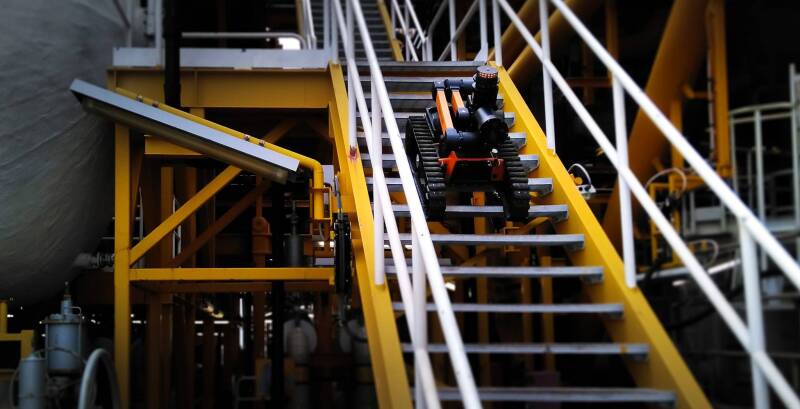French energy giant TotalEnergies is in the midst of its most ambitious pilot yet aimed at proving that ground-based robots are a critical stepping stone toward realizing the grand vision of removing human workers from large production facilities.
Launched in June, the 6-month pilot involves two robots onboard the Pazflor floating production, storage, and offloading (FPSO) unit that is located more than 90 miles off the coast of Angola with a capacity of 220,000 B/D.
The project comes 3 years after TotalEnergies began its first full-scale pilots with the tracked robots that can climb grated stairways and recharge themselves in docking stations specifically designed for hazardous work environments.
The robotic duo were sent to the Pazflor FPSO to carry out routine inspections of two oil separation modules that span five decks. TotalEnergies anticipates that these robots will be capable of executing 96% of inspection tasks that are typically done on a semiannual basis.
The Pazflor Pilot
New details about the project were recently shared at ADIPEC in Abu Dhabi. As described in SPE 216285, the complex scope and expansive work area allowed to the robots represents a “step change” over TotalEnergies' previous robotic deployments.
"Until 2022, the scope of activities for a robot deployed during a pilot was performed manually, defining a few dozen points of interest, and preparing it manually in the system," the authors stated.
By contrast, the robots at Pazflor have been assigned to about 1,700 points of interest, a workload deemed unmanageable for human operators. Consequently, TotalEnergies has turned to a maintenance analysis software to define the robots' operational scope for the first time.

Marking another first for TotalEnergies, the company is using a separate software called a robot supervision system (RSS) to manage most aspects of daily robot activity.
Co-developed by TotalEnergies and its technology partner Kalypso, a subsidiary of Rockwell Automation, the RSS leverages video game engine technology to plan inspection missions autonomously and relay data back to humans in the control room.
But of course, the other critical piece to the ongoing project are the robots themselves.
Developed with the backing of TotalEnergies, Equinor, Petrobras, and the UK's Net Zero Technology Centre, the Taurob robot built by a German company with the same name has been touted as the world's first "offshore work-class robot."
The tracked units are fitted with high-definition cameras, audio recording capabilities, thermal imaging, and 3D LIDAR for navigation. They will also be used to test new machine learning algorithms developed by TotalEnergies for specific inspections of valves, gears, and lighting. The French oil company has also installed a dedicated private 4G network to enable reliable communication with the robots across all decks of the FPSO.
Pathway to Unmanned Facilities
TotalEnergies’ ultimate objective is the broader application of normally unmanned facilities (NUF) which the company considers to be a “new frontier for cost reductions.” According to the paper, TotalEnergies envisages two pathways to realizing the NUF concept.
While the first involves intensive automation, increasing both complexity and costs, the second limits automation to essential functions like safety and process controls, relying instead on ground robots for operational tasks. Opting for the latter, TotalEnergies reports achieving cost efficiencies and simplifying the process of retrofitting its facilities for robotic operations.
The pilot offshore Angola builds upon a series of smaller-scope tests conducted in the Netherlands, the UK, and Qatar. According to previous reports, a prior year-long deployment in the Shetland Islands using four tracked robots at an onshore gas plant yielded approximately £275,000 (~$334,000) in maintenance and inspection savings.
For Further Reading
SPE 216285 Ground Robotics: A Comprehensive Journey Towards Remote Operations by Jean Michel Munoz, Eric Bartoli, Gildas Collin, and Philippe Grenier, TotalEnergies.


